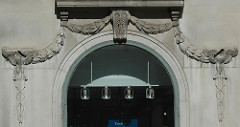
Balustrade: a continuous railing comprised of Balusters
Chair favored by both men and women/most characteristic chair of the French Renaissance.
Verticality is still emphasized; use of perspective (attempt) in the back of the chair.
Continuous perimeter stretcher; has a bun foot (smushed circle).
References to classical antiquities → only way you can tell its Renaissance (motifs).
A central case at eye level; usually 2 doors on either side of a central panel
No pyramidal or connacle-rectilinear.
Inspired by classical motifs, BUT did not understand proportions.
Italian styles entering France
Used walnut wood paneling, heavy use of framing, chairs/benches (any furniture) against the wall, parquet flooring.
Use of proportion in paintings-painted by Italians.
Down-turning arms terminating in ram’s head.
Down-turning arms terminating in ram’s head (key to determining if furniture is from FRENCH RENAISSANCE).
Legs were designed as slender round plain columns mounted on bun feet.
Referenced classical antiquity in motifs/columns
Carved romayne medallion on chair back: a motif consisting of a head within a roundel
Use of classical forms; lower section wider than upper.
Made in 2 pieces-to make it more easily portable/transferable.
Stored clothing.

Monumental bed, placed on dais.
Walls that are painted with pattern, open beamed/flattened ceiling system that is painted.
Fireplace has decorative pattern.
All the furniture is placed along the wall.
Tapestry behind bed-huge; bed still on a dais.
Italian influence: chair sedia, terra cotta flooring.
Tapestries on walls, ceiling beams painted.
Ceiling is coffered, made reference to the Medicis (in Catherine’s room)-abstracted cartouche of Medici; Medici seal with unification of Italy and France with the French symbol.
Meant that many Protestants that were artists, craftsmen, who had been persecuted under Spanish control, they immigrated into France.
Carved solid plat; down-turning arms, terminating in ram’s head.
Legs joined by H-Stretcher; legs mounted on bun feet.
Patronage of the arts → Henry IV creates factories (carpet, silk, etc.) for artists so they’d have a place to work.
Wall panels are enlarged, seen in a diversity of shapes and sizes; fields of the panels are painted.
Huge beams open up to large areas where they’d place paintings.
Chandeliers are introduced, furniture is still placed against the walls.
Jacques de Cerceau




